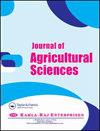用景观特征分析评价保护区与非保护区的关系——以雷山国家公园为例
IF 0.7
Q3 AGRICULTURE, MULTIDISCIPLINARY
引用次数: 2
摘要
本文介绍了土耳其库尔山国家公园的景观特征分析方法。本研究评估了国家公园、缓冲区及其破碎状态中景观特征类型分布的结构性差异。可以看出,这些差异是由生物和非生物因素引起的,但这些非生物因素对生物多样性减少、解体和隔离值增加的影响更大。通过对该盆地的分析,确定了345种景观特征类型。国家公园保护区与农村地区的地表面积虽然数值相近,但在景观特征比和斑块比上存在显著差异。农村地区的不稳定程度更高。从香农多样性指数(SDI)来看,农村地区景观特征类型(LCT)具有较高的多样性。与库尔山国家公园相比,农村地区的景观多样性更高,景观特征类型的区域分布更有规律。根据国家公园保护和国家公园规划区的价值,规划区内的斑块率和景观多样性较高,景观特征类型的面积分布较为不规则。本文章由计算机程序翻译,如有差异,请以英文原文为准。
Using Landscape Character Analysis To Assess The Relationship Between Protected and Nonprotected Areas: The Case of The Küre Mountains National Park
This paper describes the landscape character analysis method within the Kure Mountains National Park in Turkey. This study assesses structural differences in the distribution of landscape character types in the National Park, buffer zone and their fragment states. It is seen that these differences arise from biotic and abiotic factors but those abiotic factors have a stronger impact on diminishing biological diversity, disintegration and increase of isolation values. Through the basin were identified 345 landscape character types. Despite having similar values, the surface area of the protected area in the national park and the rural area are of significant differences in landscape character ratios and patchiness ratio. Patchiness is seen to be higher in rural areas. When looked at Shannon Diversity Index (SDI) values, it is seen that a high diversity of Landscape Character Types (LCT) exist in the rural area. Landscape diversity is higher in the rural area compared to the Kure Mountains National Park and the areal distribution of landscape character types is more regular. According to the National Park protection and National Park planning area values the patchiness ratio in the planning area as well as the landscape diversity is high and the areal distribution of landscape character types is more irregular.
求助全文
通过发布文献求助,成功后即可免费获取论文全文。
去求助
来源期刊

Journal of Agricultural Sciences
AGRICULTURE, MULTIDISCIPLINARY-
CiteScore
1.80
自引率
0.00%
发文量
0
 求助内容:
求助内容: 应助结果提醒方式:
应助结果提醒方式:


